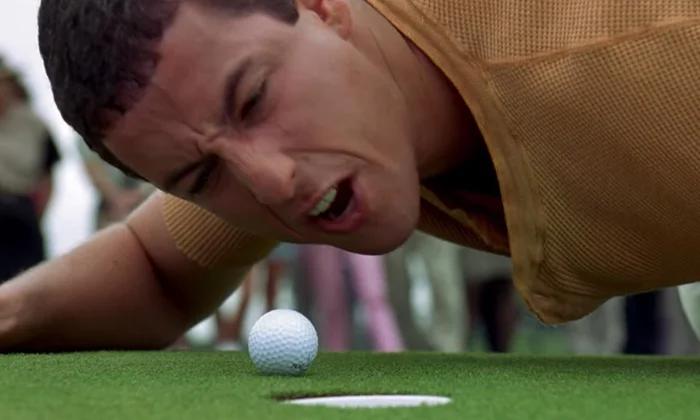By: Andrew J. Hewitt, PMHNP-BC
Abstract
This paper explores the psychological profile of Happy Gilmore, the protagonist of the Happy Gilmore films. Through the lens of the DSM-5-TR, we examine his behavioral patterns, emotional responses, and coping mechanisms. The analysis focuses on his manifestations of anger, anxiety, and the defense mechanisms he employs, providing insights into his mental health and development throughout the film.Mentalyc+1ifeet.org+1
Introduction
Happy Gilmore presents a unique opportunity to analyze a fictional character’s psychological landscape. Happy, a failed hockey player turned golfer, exhibits a range of behaviors that align with various psychological constructs. By applying the Diagnostic and Statistical Manual of Mental Disorders, Fifth Edition, Text Revision (DSM-5-TR), we can dissect these behaviors to understand the underlying mental health issues and coping strategies.123HelpMe+2eJournals Universitas Mulawarman+2Cram+2Bartleby+4Wikipedia+4LinkedIn+4ifeet.org
Anger and Aggression
Happy’s frequent outbursts and aggressive behaviors are central to his character. According to the DSM-5-TR, Intermittent Explosive Disorder (IED) is characterized by recurrent behavioral outbursts representing a failure to control aggressive impulses (American Psychiatric Association, 2022). Happy’s episodes, such as attacking his boss with a hockey stick or fighting with fellow golfers, may suggest IED. However, these behaviors often occur in response to specific provocations, indicating a possible alignment with the frustration-aggression hypothesis, which posits that aggression is often the result of blocking, or frustrating, a person’s efforts to attain a goal (Berkowitz, 1989).
Anxiety and Defense Mechanisms
Happy experiences various forms of anxiety throughout the film. A study analyzing his character identified neurotic, moral, and realistic anxiety as prevalent types he encounters (Sari, 2022). Neurotic anxiety arises from an unconscious fear that the basic impulses of the id will take control, leading to punishment. Moral anxiety stems from a fear of violating moral or societal codes, while realistic anxiety is a fear of real-world events. To cope, Happy employs defense mechanisms such as displacement, redirecting his anger from the actual source to a safer target, and sublimation, channeling his aggression into the socially acceptable outlet of competitive golf.Plot ExplainedeJournals Universitas Mulawarman
Adjustment Disorder
Happy’s transition from hockey to golf, prompted by his grandmother’s financial troubles, represents a significant life change. Adjustment Disorder, as defined in the DSM-5-TR, involves emotional or behavioral symptoms in response to an identifiable stressor, occurring within three months of the onset of the stressor (American Psychiatric Association, 2022). Happy’s initial struggles with adapting to the norms of professional golf, coupled with his emotional responses, align with this diagnosis.LinkedIn+6Wikipedia+6123HelpMe+6ifeet.orgCram
Personality Traits
Happy exhibits traits associated with certain personality disorders, though not to the extent of a full diagnosis. His impulsivity, difficulty conforming to social norms, and aggressive behavior suggest features of Antisocial Personality Disorder. However, his capacity for forming close relationships, such as with his grandmother and love interest, indicates a more nuanced personality structure. His character development throughout the film shows increased self-awareness and emotional regulation, moving away from these maladaptive traits.
Therapeutic Interventions
Happy’s journey illustrates the potential benefits of therapeutic interventions. His mentor, Chubbs, serves as a stabilizing figure, helping him channel his aggression into his golf performance. This mentorship mirrors therapeutic relationships where guidance and support facilitate behavioral change. Additionally, Happy’s use of visualization techniques, such as imagining his “happy place,” aligns with cognitive-behavioral strategies employed to manage stress and anxiety (Optimize Mind Performance, 2024).Claire McShane’s Digital StorytellingOptimize Mind Performance
Conclusion
Happy Gilmore’s character provides a compelling case study for examining anger, anxiety, and defense mechanisms through a psychiatric lens. While his behaviors often border on pathological, his capacity for growth and adaptation underscores the complexity of psychological diagnoses. The film, while comedic, offers valuable insights into human behavior and the potential for change.
References
American Psychiatric Association. (2022). Diagnostic and statistical manual of mental disorders (5th ed., text rev.; DSM-5-TR). Washington, DC: Author.
Berkowitz, L. (1989). Frustration-aggression hypothesis: Examination and reformulation. Psychological Bulletin, 106(1), 59–73.
Optimize Mind Performance. (2024). Happy Gilmore: Fiction grounded in fact. Retrieved from https://optimizemindperformance.com/happy-gilmore/
Sari, A. (2022). The anxiety and defense mechanism of Gilmore in Happy Gilmore movie. Journal of Behavioral Studies in Social Behavior, 2(1), 45–53. Retrieved from https://e-journals.unmul.ac.id/index.php/JBSSB/article/view/6354/pdf

